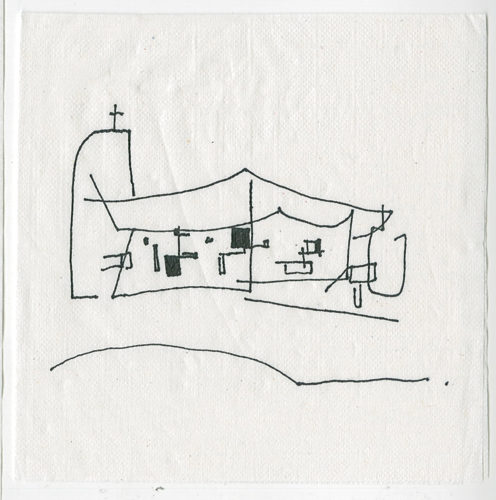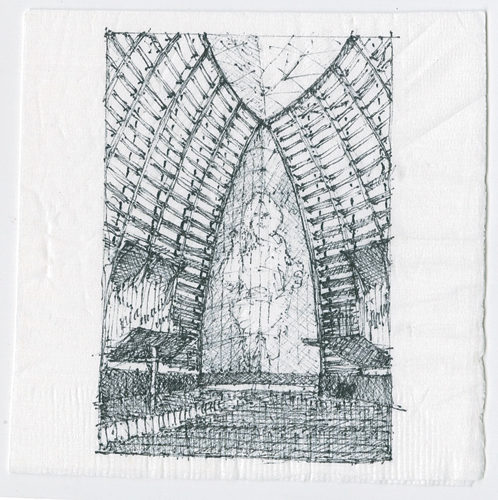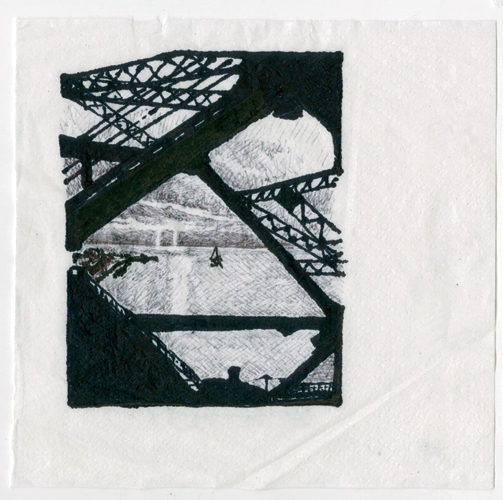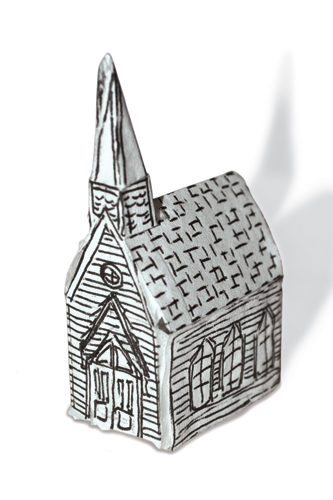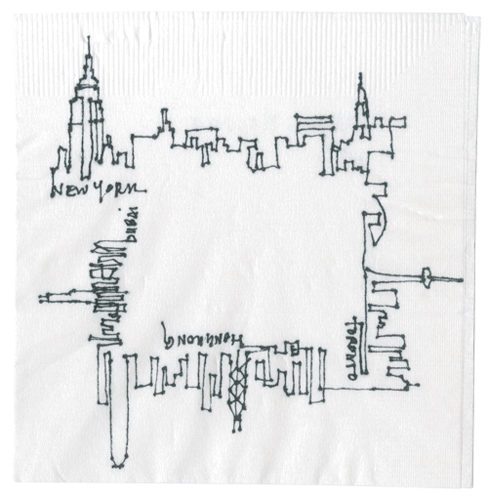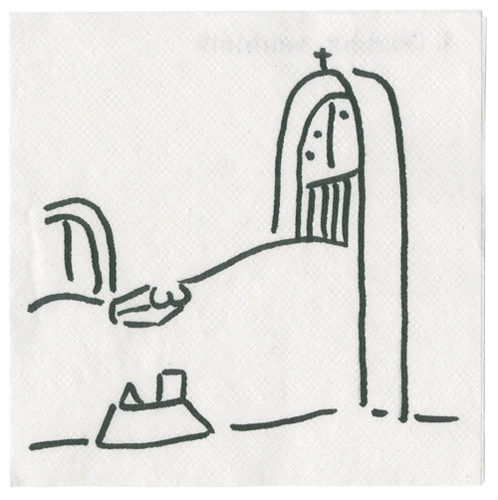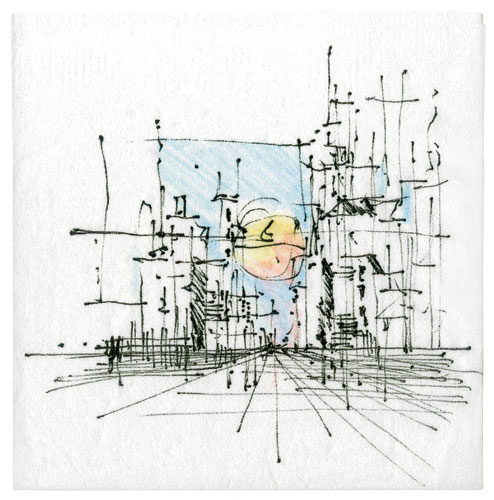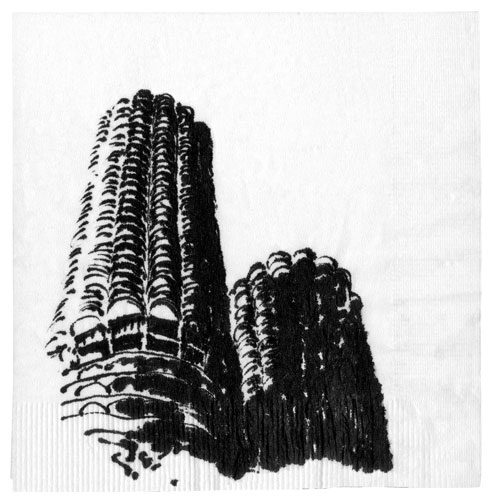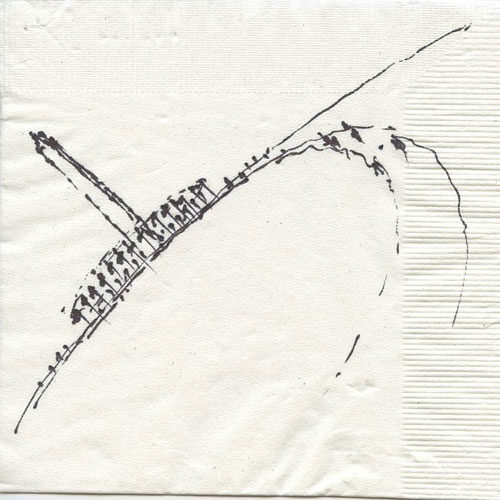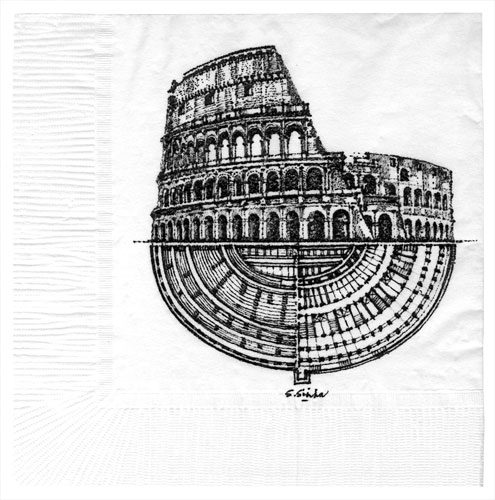Photo Galleries
Winner, Non-professional
The winning cocktail napkin sketch by a nonprofessional was drawn by Amanda Prosser, who received her M.Arch. from Kansas State University. With jobs in architecture so scarce, she currently works for a life insurance firm. The jury found Prosser’s sketch of Notre Dame du Haut, Le Corbusier’s famous chapel at Ronchamp, France (1954), to exhibit a startling economy and elegance of line. When Prosser visited Ronchamp as a student, she drew the building in a sketchbook with her eyes closed. “Back in Topeka, I decided to see if I could do it on a cocktail napkin with an extra-fine black ballpoint pen,” she says. “I did it again without opening my eyes.”
Runners-Up, Professional
The jury awarded cocktail napkin sketches that reflect the spontaneous act of creativity underlyling this ephemeral art form. While a number of entrants treated the cocktail napkin sketch as an exercise in more time-consuming rendering, the jurors admired the artistry of these exercises and included several runners-up that belong to this category.
Runners-Up, Non-professional
The jury awarded cocktail napkin sketches that reflect the spontaneous act of creativity underlyling this ephemeral art form. While a number of entrants treated the cocktail napkin sketch as an exercise in more time-consuming rendering, the jurors admired the artistry of these exercises and included several runners-up that belong to this category.
Hors de Concour
Contestants were asked to submit sketches on a 5-inch-square cocktail napkin, a stipulation that many blithely ignored. But Record’s jury stuck by the rules—with one exception: a tiny, delicate model of a church by Scott Grove (an artist) in which the cocktail napkin was made to act like balsa wood. Record created an “hors de concour” (out of the running) award. We couldn’t resist it.
Off Beat
Madcap entries from this year's contest included a series of plays-on-words, portraits, and new conceptualizations of notable monuments. A series of highlights from those submissions follows.
Ronchamp
We received a number of sketches of Le Corbusier's acclaimed Notre Dame du Haut in Ronchamp, France (1954). Here is a selection of those napkins, all of which shed new light on this classic Modern landmark.
Winner, Professional
Geoff Parker, 38, an Oklahoma City native who recently joined 308 Design Collaborative, teaches first- and second-year studio art courses to undergraduates at the University of Oklahoma, where he received his B.Arch. and M.Arch. Parker spent about 10 minutes on his sketch, which he says is a quick doodle of an imaginary cityscape. “I was playing around with perspective and trying to generate some depth,” he says. The architect drew the sketch using a fountain pen and colored pencils and explains, “I was intentionally trying to see how fast and loose I could draw it and still make it read.” With a father who is also an architect, Parker says he’s known from childhood that architecture was his calling.
Winner, Non-professional
The winning sketch by a nonprofessional was drawn by Brian Droste, 25, an intern at the firm Wight & Company. While enrolled in the five-year architecture program at Notre Dame, Droste studied in Rome, where a professor introduced him to light-and-shadow drawing studies, the inspiration for his sketch. Droste says he has always been fascinated by the work of architect Bertrand Goldberg, and his Marina City (1964) in particular, because of the way light bounces across the buildings, emphasizing petal-like forms. Droste completed his sketch in about 10 minutes using a fountain pen. “The pen bleeds so quickly—it makes you go so much faster,“ he says. “You have to commit and not go back, almost like a watercolor.”
Runners-Up, Professional
In the professional category, the jury awarded cocktail napkin sketches that ranged from quick sketches of iconic buildings to whimsical studies on the design process. The jurors generally favored sketches that looked more like late-night handiwork done in a dimly lit bar than carefully crafted renderings, though they did select a few of each, including vibrant sketches of agricultural buildings and the Washington Monument.
Runners-Up, Non-professional
Submissions in the nonprofessional category ran the gamut: We received hundreds of sketches of built masterworks—both ancient and modern—found across the globe. Ninetieth and twentieth century buildings, particularly those designed by architects Frank Lloyd Wright, Louis Kahn, Frank Gehry, and Antonio Gaudi, dominated the submissions. The diversity of submissions is reflected in the jury’s selections, which range from an impeccable rendering-like drawing of the Colosseum in Rome to an exquisitely simple sketch of Jeanne Gang’s Aqua Tower in Chicago.
Copyright ©2024. All Rights Reserved BNP Media.
Design, CMS, Hosting & Web Development :: ePublishing
